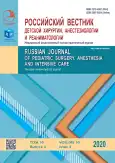Method of spleen reduction in laparoscopic splenectomy in children with hereditary autoimmune hemolytic anemia
- Authors: Svarich V.G.1,2, Kagantsov I.M.2,3, Svarich V.A.4
-
Affiliations:
- Republican Сhildren’s Clinical Hospital
- Syktyvkar Pitirim Sorokin State University
- V.A. Almazov National Medical Research Center
- Main Bureau of Medical and Social Expertise in the Republic of Komi
- Issue: Vol 10, No 4 (2020)
- Pages: 429-433
- Section: Original Study Articles
- URL: https://journals.rcsi.science/2219-4061/article/view/122940
- DOI: https://doi.org/10.17816/psaic710
- ID: 122940
Cite item
Full Text
Abstract
Purpose. This study aimed to improve the results of surgical treatment of children with hereditary autoimmune hemolytic anemia by laparoscopic splenectomy.
Materials and methods. In the period from 1991 to 2020, a total 47 patients with hereditary autoimmune hemolytic anemia were treated in the surgical department of the Republican Children’s Clinical Hospital of Syktyvkar. Splenectomy was performed by the open method in 25 children, and laparoscopic method in 22 patients. Since 2019, the method of spleen reduction during laparoscopic splenectomy has been used in 3 patients when the large size of the mobilized spleen does not correspond to the size of the endoscopic container.
Results. On average, surgical intervention using the above-described method of spleen reduction lasted for 19 ± 2 min lesser than with laparoscopic splenectomy without the above method, due to the possibility of removing a significantly smaller volume of spleen tissue from the endoscopic sac outside the abdominal cavity. However, the most important achievement was the almost complete elimination of the risk of getting free fragments of a pathologically altered spleen with its possible replantation and recurrence of the clinic of autoimmune hemolytic anemia. The postoperative period was smooth, and all patients were discharged at their place of residence 7 days after the laparoscopic splenectomy. Intra-abdominal complications and relapses of the disease associated with the above-described method of operation did not occur in any patient within 6–12 months postoperative.
Conclusion. The proposed method of spleen reduction during laparoscopic splenectomy made it possible to avoid relapses of the disease, reduce the operation time, as a result, improved the results of surgical treatment in children with hereditary autoimmune hemolytic anemia.
Full Text
##article.viewOnOriginalSite##About the authors
Vyacheslav G. Svarich
Republican Сhildren’s Clinical Hospital; Syktyvkar Pitirim Sorokin State University
Author for correspondence.
Email: svarich61@mail.ru
Dr. Sci. (Med.), Head of the surgical department, professor of the department of surgery of the medical institute
Russian Federation, Syktyvkar; SyktyvkarIlya M. Kagantsov
Syktyvkar Pitirim Sorokin State University; V.A. Almazov National Medical Research Center
Email: ilkagan@rambler.ru
Dr. Sci. (Med.), Chief Researcher of the laboratory of surgery of congenital and hereditary pathology, professor of the department of surgery of the medical institute
Russian Federation, Syktyvkar; Saint PetersburgVioletta A. Svarich
Main Bureau of Medical and Social Expertise in the Republic of Komi
Email: svarich61@mail.ru
Deputy Chief Expert for Clinical Expert Work
Russian Federation, SyktyvkarSupplementary files






